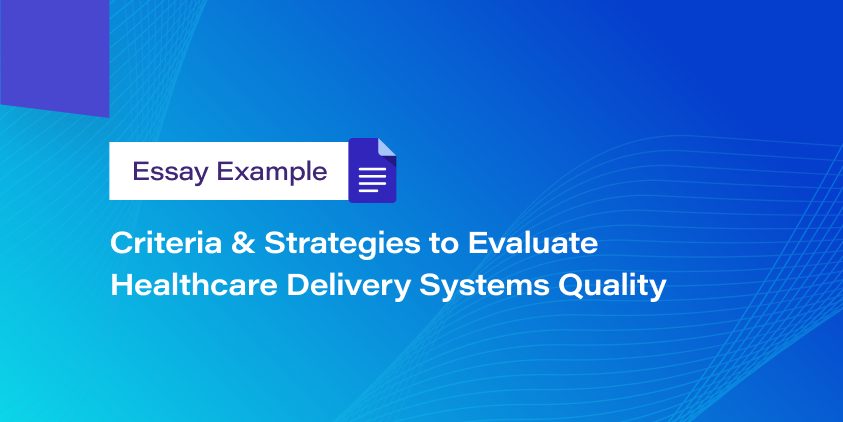Criteria & Strategies to Evaluate Healthcare Delivery Systems Quality

Healthcare quality denotes how health services increase the chances of preferred health outcomes for populations and individuals. In this case, it refers to the degree to which services provided by the benefits provider improve the general welfare of the employees health-wise. The main objective of any healthcare system is to offer a combination of medical services that optimizes the targeted group’s health. This paper will discuss the criteria that a healthcare administrator can use to evaluate the services a health benefits contractor provides. An outcomes measurement strategy to assess the quality of care will also be discussed.
Evaluation of the Healthcare Delivery Systems
Measuring health care quality is a complex task because it comprises diverse components that vary from patient to patient. Further, developing a mutually agreeable criterion for every health professional is almost impossible. Therefore, to assess the quality, various aspects of the system have to be looked into, including the structure, process and outcome (Fisher et al., 2012).
The first aspect that can be used to measure quality is the structure. This refers to those stable elements of a healthcare delivery system that promote or inhibit providing and accessing services. This structure includes provider characteristics such as years of practice, board certification status, and the specialty mix. Structural quality is often assessed through organizational accreditation by bodies such as the American Accreditation Healthcare Organization that accredit various aspects of the system, ranging from hospitals and labs available to institutionalized care. These bodies issue reports on the compliance of benefits providers with certain standards. Such reports can assist the administrator in gauging the quality of services offered by the benefits provider.
The other aspect that can be used in the evaluation is the process. A process is what occurs during patient-provider encounters. It consists of technical and interpersonal excellence, which means the intervention’s appropriateness and the humane and responsive nature of care afforded to sick individuals. The adequacy of an intervention may be assessed to establish whether employees’ lives are treated using justifiable means and not means that could jeopardize their lives. For instance, doctors should not recommend surgery where simple medical interventions will be sufficient. The interpersonal quality of care, that is, the humane and responsive nature, may be evaluated through ratings by the consumers, in this case, workers in my organization (Brown et al., 2010).
The final aspect that can be used in the evaluation is the outcome. Outcome denotes the program’s effect on the health status of the employees in my organization. This aspect should be the underlying measure of healthcare quality assessment as it measures the program’s direct effect, including the results of the efforts to prevent, protect, diagnose, and treat health ailments.
Outcomes Measurement Strategy
Outcomes are the observable results of the health care system’s performance that the administrator can use to assess the quality of services provided. Three strategies can be used to assess outcomes, including condition-specific, generic, and sentinel approaches (Owens et al., 2010). The condition-specific approach examines the results for persons with particular conditions. It involves evaluating how employees with certain conditions are handled and managed. The generic approach examines certain aspects, such as changes in functional status, mortality, patient satisfaction, and others, that can be measured even when employees are healthy. The last strategy, the sentinel approach, measures the events or aspects often associated with poor quality and checks the frequency with which the organization repeats it.
Conclusion
The above discussion has focused on evaluating the quality of healthcare delivery systems. The discussion has proposed a criterion for evaluating various system aspects. The measured aspects include the structure, process and outcomes. Another area of discussion has outlined the strategies that can be used to measure outcomes. These strategies include condition-specific, generic and sentinel approaches.
📎 References:
1. Brown, J. S., Holmes, J. H., Shah, K., Hall, K., Lazarus, R., & Platt, R. (2010). Distributed health data networks: a practical and preferred approach to multi-institutional evaluations of comparative effectiveness, safety, and quality of care. Medical care, 48(6), S45-S51.
2. Fisher, E. S., Shortell, S. M., Kreindler, S. A., Van Citters, A. D., & Larson, B. K. (2012). A framework for evaluating accountable care organizations’ formation, implementation, and performance. Health Affairs, 31(11), 2368-2378.
3. Owens, D. K., Lohr, K. N., Atkins, D., Treadwell, J. R., Reston, J. T., Bass, E. B., … & Helfand, M. (2010). AHRQ series paper 5: grading the strength of a body of evidence when comparing medical interventions—Agency for Healthcare Research and Quality and the Effective Healthcare Program. Journal of Clinical Epidemiology, 63(5), 513-523.
